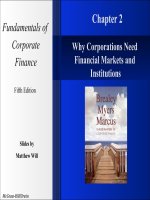Solution fundamentals of corporate finance brealy 4th chapter text solutions ch 1
Bạn đang xem bản rút gọn của tài liệu. Xem và tải ngay bản đầy đủ của tài liệu tại đây (61.6 KB, 8 trang )
Solutions to Chapter 1
The Firm and the Financial Manager
1.
real
executive airplanes
brand names
financial
stock
investment
capital budgeting
financing
2.
A firm might cut its labor force dramatically which could reduce immediate expenses
and increase profits in the short term. Over the long term, however, the firm might not
be able to serve its customers properly or it might alienate its remaining workers; if so,
future profits will decrease, and the stock price will decrease in anticipation of these
problems.
Similarly, a firm can boost profits over the short term by using less costly materials
even if this reduces the quality of the product. Once customers catch on, sales will
decrease and profits will fall in the future. The stock price will fall.
The moral of these examples is that, because stock prices reflect present and future
profitability, the firm should not necessarily sacrifice future prospects for short-term
gains.
3.
The key advantage of separating ownership and management in a large
corporation is that it gives the corporation permanence. The corporation continues
to exist if managers are replaced or if stockholders sell their ownership interests to
other investors. The corporation’s permanence is an essential characteristic in
allowing corporations to obtain the large amounts of financing required by many
business entities.
4.
A sole proprietorship is easy to set up with a minimum of legal work. The business
itself is not taxed. For tax purposes, the income of the proprietorship is treated as the
income of the proprietor. The disadvantages of a proprietorship are unlimited liability
for the debts of the firm, and difficulty in raising large amounts of capital as the
business grows.
1-1
Copyright © 2006 McGraw-Hill Ryerson Limited
A partnership has the same tax advantage as the proprietorship. The partnership per se
does not pay taxes. The partnership files a tax return, but all of the partnership
income is allocated to the partners and treated as personal income. Also, it is fairly
easy to set up a partnership. Because there can be many partners, a partnership can
raise capital more easily than a proprietorship. However, like sole proprietors,
partners have unlimited liability for the debts of the firm. In fact, each partner has
unlimited liability for all the business’s debts, not just his or her share.
Corporate organization has the advantage of limited liability. It also allows for
separation of ownership and management, since shares in the firm can be traded
without changing management. The corporation also has easier access to capital
markets. The major disadvantage of corporate organization is the double taxation of
income. Corporations pay taxes on their income, and that income is taxed again when
it is passed through to shareholders in the form of dividends. Another disadvantage of
corporate organization is the extra time and cost required in order to manage a
corporation’s legal affairs. These costs arise because the corporation must be
chartered and is considered a distinct legal entity. Such administrative costs are
significant only for small corporations, however.
LLP’s may be considered to be hybrid organizations to the extent that while individual
partners have unlimited liability, they are not liable for the actions of their partners.
5.
Double taxation means that a corporation’s income is taxed first at the corporate tax
rate, and then, when the income is distributed to shareholders as dividends, the
income is taxed again at the shareholder’s personal tax rate.
6.
a, c, d.
7.
Ball Construction Inc owes its origin to Harold and Frank Ball. It was founded as
a partnership in 1923. The partnership has evolved into Ball construction Inc of
Kitchener, Ontario, with two main divisions (Main contract and special contract
division). The website of the company is at />
8.
Provides a description of how to use the Standard and Poor’s Market Insight
database which accompanies the textbook.
9.
a.
b.
c.
d.
e.
f.
g.
h.
A share of stock
A personal IOU
A trademark
A truck
Undeveloped land
The balance in the firm’s checking account
An experienced and hardworking sales force
A bank loan agreement
1-2
Copyright © 2006 McGraw-Hill Ryerson Limited
financial
financial
real
real
real
financial
real
financial
10.
Capital budgeting decisions
Should a new computer be purchased?
Should the firm develop a new drug?
Should the firm shut down an unprofitable factory?
Financing decisions
Should the firm borrow money from a bank or sell bonds?
Should the firm issue preferred stock or common stock?
Should the firm buy or lease a new machine that it is committed to acquiring?
11.
The stock price reflects the value of both current and future dividends the shareholders
will receive. In contrast, profits reflect performance in the current year only. Profit
maximizers may try to improve this year’s profits at the expense of future profits. But
stock price maximizers will take account of the entire stream of cash flows that the firm
can generate. They are more apt to be forward looking.
12.
a.
This action might appear, superficially, to be a grant to former employees and
thus not consistent with value maximization. However, such ‘benevolent’
actions might enhance the firm’s reputation as a good place to work, might
result in greater loyalty on the part of current employees, and might contribute
to the firm’s recruiting efforts. Therefore, from a broader perspective, the
action may be value maximizing.
b.
The reduction in dividends to allow increased reinvestment can be consistent
with maximization of current market value. If the firm has attractive
investment opportunities, and wants to save the expenses associated with
issuing new shares to the public, then it could make sense to reduce the
dividend in order to free up capital for the additional investments.
c.
The corporate jet would have to generate benefits in excess of its costs in
order to be considered stock-price enhancing. Such benefits might include
time savings for executives, and greater convenience and flexibility in travel.
a.
Increased market share can be an inappropriate goal if it requires reducing prices
to such an extent that the firm is harmed financially. Increasing market share
can be part of a well-reasoned strategy, but one should always remember that
market share is not a goal in itself. The owners of the firm want managers to
maximize the value of their investment in the firm.
b.
Minimizing costs can also conflict with the goal of value maximization. For
example, suppose a firm receives a large order for a product. The firm should be
willing to pay overtime wages and to incur other costs in order to fulfill the
order, as long as it can sell the additional product at a price greater than those
costs. Even though costs per unit of output increase, the firm still comes out
ahead if it agrees to fill the order.
13.
1-3
Copyright © 2006 McGraw-Hill Ryerson Limited
c.
A policy of underpricing any competitor can lead the firm to sell goods at a price
lower than the price that would maximize market value. Again, in some
situations, this strategy might make sense, but it should not be the ultimate goal
of the firm. It should be evaluated with respect to its effect on firm value.
d.
Expanding profits is a poorly defined goal of the firm. The text gives three
reasons:
(i)
There may be a trade-off between accounting profits in one year versus
accounting profits in another year. For example, writing off a bad
investment may reduce this year’s profits but increase profits in future
years. Which year’s profits should be maximized?
(ii)
Investing more in the firm can increase profits, even if the increase in
profits is insufficient to justify the additional investment. In this case the
increased investment increases profits, but can reduce shareholder wealth.
(iii) Profits can be affected by accounting rules, so a decision that increases
profits using one set of rules may reduce profits using another.
14.
The contingency arrangement aligns the interests of the lawyer with those of the
client. Neither makes any money unless the case is won. If a client is unsure about
the skill or integrity of the lawyer, this arrangement can make sense. First, the lawyer
has an incentive to work hard. Second, if the lawyer turns out to be incompetent and
loses the case, the client will not have to pay a bill. Third, the lawyer will not be
tempted to accept a very weak case simply to generate bills. Fourth, there is no
incentive for the lawyer to charge for hours not really worked. Once a client is more
comfortable with the lawyer, and is less concerned with potential agency problems, a
fee-for-service arrangement might make more sense.
15.
The national chain has a great incentive to impose quality control on all of its outlets.
If one store serves its customers poorly, that can result in lost future sales. The
reputation of each restaurant in the chain depends on the quality in all the other stores.
In contrast, if Joe’s serves mostly passing travelers who are unlikely to show up again,
unsatisfied customers pose a far lower cost. They are unlikely to be seen again
anyway, so reputation is not a valuable asset.
The important distinction is not that Joe has one outlet while the national chain has
many. Instead, it is the likelihood of repeat relations with customers and the value of
reputation. If Joe’s were located in the center of town instead of on the highway, one
would expect his clientele to be repeat customers from town. He would then have the
same incentive to establish a good reputation as the chain.
16.
While a compensation plan that depends solely on the firm’s performance would serve
to motivate managers to work hard, it would also burden them with considerable
personal risk tied to the fortunes of the firm. This would be unattractive to managers
1-4
Copyright © 2006 McGraw-Hill Ryerson Limited
and might cause them to value their compensation packages less highly; it might also
elicit excessive caution when evaluating business opportunities.
17.
Takeover defenses make it harder for underperforming managers to be removed by
dissatisfied shareholders, or by firms that might attempt to acquire the firm. By
protecting such managers, these provisions exacerbate agency problems.
18.
Traders can earn huge bonuses when their trades are very profitable, but if the
trades lose large sums, as in the case of Barings Bank, the trader’s exposure is
limited. This asymmetry can create an incentive to take big risks with the firm’s
(i.e., the shareholders’) money. This is an agency problem.
19.
a.
A fixed salary means that compensation is (at least in the short run) independent
of the firm’s success.
b.
A salary linked to profits ties the employee’s compensation to this measure of
the success of the firm. However, profits are not a wholly reliable way to
measure the success of the firm. The text points out that profits are subject to
differing accounting rules, and reflect only the current year’s situation rather
than the long-run prospects of the firm.
c. A salary that is paid partly in the form of the company’s shares means that the
manager earns the most when the shareholders’ wealth is maximized. This is
therefore most likely to align the interests of managers and shareholders.
d. Stock options create great incentives for managers to contribute to the firm’s
success. In some cases, however, stock options can lead to agency problems. For
example, a manager with many options might be tempted to take on a very risky
project, reasoning that if the project succeeds the payoff will be huge, while if it
fails, the losses are limited to the lost value of the options. Shareholders, in
contrast, bear the losses as well as the gains on the project, and might be less
willing to assume the risk.
20.
Even if a shareholder could monitor and improve managers’ performance, and thereby
increase the value of the firm, the payoff would be small, since the ownership share in
a large corporation is very small. For example, if you own $10,000 of GM stock and
can increase the value of the firm by 5 percent, a very ambitious goal, you benefit by
only: (0.05 × $10,000) = $500.
In contrast, a bank that has a multimillion-dollar loan outstanding to the firm has a
large stake in making sure that the loan can be repaid. It is clearly worthwhile for the
bank to spend considerable resources on monitoring the firm.
21.
Long-term relationships can encourage ethical behavior. If you know that you will
engage in business with another party on a repeated basis, you will be less likely to
take advantage of your business partner if an opportunity to do so arises. When
people say "what goes around comes around," they recognize that the way they deal
1-5
Copyright © 2006 McGraw-Hill Ryerson Limited
with their associates will influence the way their associates treat them. When
relationships are short-lived, however, the temptation to be unfair is greater since there
is less reason to fear reprisal, and less opportunity for fair dealing to be reciprocated.
22.
As the text notes, the first step in doing well is doing good by your customers.
Businesses cannot prosper for long if they do not provide to their customers the
products and services they desire. In addition, reputation effects often make it in the
firm’s own interest to act ethically toward its business partners and employees since
the firm’s ability to make deals and to hire skilled labor depends on its reputation for
dealing fairly.
In some circumstances, when firms have incentives to act in a manner inconsistent
with the public interest, taxes or fees can align private and public interests. For
example, taxes or fees charged on pollution make it more costly for firms to pollute,
thereby affecting the firm’s decisions regarding activities that cause pollution. Other
“incentives” used by governments to align private interests with public interests
include: legislation to provide for worker safety and product, or consumer, safety,
building code requirements enforced by local governments, and pollution and gasoline
mileage requirements imposed on automobile manufacturers.
23.
Some customers might consider this practice unethical. They might view the firm
as gouging its customers during heat waves. On the other hand, the firm might try
to convince customers that this practice allows it to charge lower prices in cooler
periods, and that over long periods of time, prices even out. Whether customers and
firms have an “implicit contract” to charge and pay stable prices is something of a
cultural issue.
24.
Rules and regulations governing different forms of business share similarities and
differences across provinces. For example, in Prince Edward Island, partnerships
are governed by the Partnership Act. Within 3 months of forming a partnership, a
declaration of partnership must be registered (cost $ 60) which is valid for three
years. In Quebec however, a declaration of registration with the applicable fees is
required within 60 days following the day on which the business is started.
Provinces usually require that a name search be done prior to a business being
registered as a partnership or sole proprietor (eg. Quebec or PEI). However, if a
sole proprietor is starting a business under their first and last names, they may not
be required to register the business. Registration requirements are usually less
stringent or, at times, even exempt, for sole proprietorships named after the
proprietor (first and last name). However, if the business name doing not include
the owners full name then registration is usually required.
Provinces have similar rules for forming corporations. Prior to incorporation, a
name search is required. The search could be Canada wide or just within a
particular province. Typically, provinces also require registration fees (eg. PEI or
Saskatchewan). Also corporations must file annual returns with the appropriate
1-6
Copyright © 2006 McGraw-Hill Ryerson Limited
provincial authorities, failing to do so could result in the corporation’s name being
struck from the Register of Corporations.
In general, while provinces enjoy the authority to regulate businesses within their
jurisdictions and may have differing statutes on occasion, closer examination
indicates that the rules and regulation are actually quite similar.
25.
Careers in Finance. Here are examples of two areas of employment in finance:
Corporate Finance- A career in corporate finance typically involves working for a
company. The nature of tasks tends to vary depending on the type and seniority of
the position. However, you may find yourself involved with having to find money
to run the business and to grow it. You are likely to be involved in other activities
as well such as examining the feasibility of investing in long run projects, making
decisions regarding how best to manage your company’s short term asset needs,
managing any cash on hand, planning for your firm’s financial future, and even
making acquisitions of other businesses. You might work for a large multinational
company or a smaller player with high growth prospects. Responsibility can come
fast and your problem-solving skills will be put to work quickly in corporate
finance.
Salary Range:
Bachelor’s degree - $25,000- $40,000
Master’s degree - $35,000 - $80,000 (and above)
Commercial Banking- providing banking services to individuals, small businesses
and large organizations. Jobs in banking can be exciting and offer excellent
opportunities to learn about the variety of business activities in which today’s banks
participate, interact with people, and build up a clientele. So, for instance, at the
branch level you may be interacting constantly with customers as a teller. You may
work in other areas of the bank’s business as well such as mortgage financing,
loans, trade credit, leasing, credit card banking and international finance.
Skills required for a successful career in the banking industry
You should have a good understanding of the bank’s overall business and how your
role fits in with the needs of the business. Many large banks engage in a wide
variety of international financing activities. It is not surprising, therefore, that
individuals with “international” exposure, training, language skills, etc. tend to do
well in such environments. Other attributes required to do well in the banking sector
may include Accounting and Writing Skills, integrity of character and a sound work
ethic, good communication skills and people management skills, etc.
Salary Range
Bachelor’s degree - $24,000- $38,000
Master’s degree- $30,000- $50,000 (and above)
1-7
Copyright © 2006 McGraw-Hill Ryerson Limited
Here are a couple of examples of entry requirements from job postings by banks in
the United States and Canada.
A mid-sized bank in the United States:– Commercial Banking Officer level 3
Requirements: Minimum 7 years experience, Bachelor’s degree in Business,
Finance or Accounting, good business development skills and strong credit skills.
A large chartered bank in Canada – Loan Products Group Associate
Requirement: 2-4 years lending or comparable experience is preferred , Bachelors
Degree, CFA or MBA a plus, Strong skills in financial and credit analysis and
modeling skills, good knowledge of lending and portfolio management, knowledge
of a broad range of credit and other banking products, computer literate. Other
attributes include flexibility and quick learning skills.
These requirements are generally similar to those listed on the careers in finance
website.
26.
The average CEO compensation in Canada for 2003 was $ 3.2 million. The highest
compensation was for $94.7 million paid to Robert McEwen, Chairman and CEO of
Goldcorp. Mr. McEwan also received the highest compensation in terms of stock
options of $94.3 million.
CEO’s ranked second and third on the compensation list had very different “option”
components in their compensation packages. For instance, Frank Stronach,
Chairman of Magna International, received a total compensation package of $53.6
million in 2003, of which $2.8 million was comprised of stock option value. In
contrast, Robert Gratton, CEO of Power Financial Corporation, received a total
compensation package of $52.4 million in which the stock options component was
worth $44.7 million.
1-8
Copyright © 2006 McGraw-Hill Ryerson Limited









